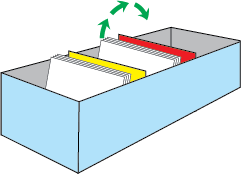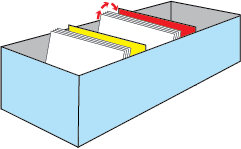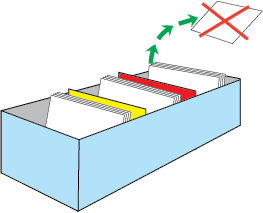This manual offers two dictionaries. The manual was created using the author's methodology. Based on the differences in the mechanisms of memory during perception and speech reproduction, two types of classification of words are proposed. The first classification contains blocks of consonant words. In this case, the types of consonances can be different. The second type of classification is based on the semantic commonality of words. The manual is designed for a wide range of people studying German.

One day a week we are going to devote to the second section, which is between the yellow and red cards in my drawing. 
And we will act exactly the same as in the first paragraph. If we remember, the tab goes into the third section, and if we don't remember, it will remain at the end of the second section deck and return in some of the subsequent reviews. Perhaps the second time you find out, you'll be much more impressed than the first time.
1.6 What does the phonemic block do?
1) Words arranged in a phonemic block are very easy to learn to read. Indeed, you know the algorithm and change only one sound. In this case, you perceive not individual letters in a word, but the whole word.
2) At the same time, the block reveals the features of spelling words. Sometimes words sound the same but are spelled differently. Phonetically, blocks emphasize this difference by placing such words next to each other.

We still have one more step to make sure the words are definitely in our minds: the monthly review. No matter what the day, what matters is what you remember. For example, it could be the first Sunday of every month. Or, if it helps you remember better, the day of the month that is your birthday. Move to the end of the deck. Do you remember? You have already learned this word. Now you can do three things with the tab: you can throw it, you can reuse it if you used a pencil, and you can remove it.
3) This comparison is also carried out in the phonemic block. In Russian, vowel sounds do not differ in length, but in German, the length of a vowel is a phoneme, i.e., their meaning changes depending on how you pronounce the vowel sound. For example, kann - I can and der Kahn - canoe/boat.
4) The words of the phonemic block are very easy to remember in German. Indeed, you take the block algorithm and create the words yourself. All that remains is to learn the correspondence/translation of these words into your native language.
Flip it over and return it to the first section so that you not only learn it from German to Spanish, but also from Spanish to German. We explain how to learn German with some simple, practical tips. Follow them and your learning process will be much faster and more effective.
Make a curriculum where you set goals and time to get them, and respect them! Integrate into daily life and go to the bakery, to the cinema, to make a purchase in German. Get research friends or a tandem: a German-speaking partner who might want to learn Spanish. Working with dictionaries and reference materials to clarify doubts easily and easily. If your level is already intermediate, it is best to use a dictionary that has explanations in German. Make teaching charts with vocabulary charts and new structures learned in class. For nouns, write the genre first, as well as the plural. For the verbs write the past tense and the past participle, as well as the auxiliary verbs used. For prepositions, write in what cases each is used and give examples. New vocabulary should always be in the context in which it is used. To carry out effective learning and accept it in a familiar way, it is necessary to make it relaxed, motivated and with visible goals in mind.
- It is best to choose a quiet place where you will not be disturbed.
- Get required material before you start and have everything at your fingertips.
- Be sure to indicate when you will pause.
- This best way learn the language.
- You can help each other during recreational activities.
- There are a large number of online dictionaries.
5) Learning phonemic blocks develops in a student of German the ability to form sound associations in German, and this ability is an integral sign of thinking in foreign language. German words should recall the remaining words of this block.
Part 1
Combining words into blocks based on consonance.
Introduction
The problem of learning words when studying
German language.
Two types of classification of minimum words
1 Phonemic classification.
1.1 What is a phoneme?
1.2 Phonemic block of words
1.3 Algorithm for composing a phonemic block of words
1.4 A number of phonemic word blocks
1.5 Three rows of phonemic blocks
1.6.1.One hundred phonemic blocks with words that differ in the first consonant
1.5.2.One hundred phonemic blocks with words that differ in the root vowel sound
1.5.3.One hundred phonemic blocks with words that differ in the last consonant.
1.6 What does the phonemic block do?
2. Human memory and the learning process.
2.1 Long-term and short-term memory
2.2 Associations
2.3 External linking.
2.4 Internal linking
3 Associative series of words - guaranteed access to information in memory.
3.1 Associative series as a support for external linking
3.2 List of associative words
3.3 How is an associative series of words composed?
3.4 Why is number-to-word conversion done?
3.5 Test confirming the advantages of using an associative series.
3.6 Learn an associative series of words
3.7 Using an associative series of words to reproduce associative blocks.
Part 2
Semantic classification of words in the minimum German language
Introduction.
1 Classification of words by parts of speech
2 Dividing verbs into semantic groups
3 Breakdown of semantic groups into blocks
I Stage verbs.
II Verbs of motion
III Verbs of presence/quantity
IV Verbs of position
V Everyday verbs
VI Verbs of feeling
VII Verbs of perception and thinking.
VIII Working operations
IX Verbs of communication.
X Verbs of struggle
4 Semantic macrostructure of the classification
Group I. Stage verbs
Group II. Verbs of movement.
Group III. Verbs of presence
Group IV. Verbs of position.
Group V Everyday verbs
Group VI. Verbs of feeling.
Group VIII. Work operations
Group IX. Verbs of communication.
Group X. Verbs of struggle
5 Minimum block filling
semantic classification
Group I. Stage verbs
Group II. Verbs of movement.
Group III. Verbs of presence/quantity.
Group IV. Position.
Group V. Everyday verbs.
Group VI. Verbs of feeling.
Group VII. Verbs of perception and thinking
Group VIII. Work operations.
Group IX. Verbs of communication.
Group X. Verbs of struggle
6 Verbal minimum of the basic level, classified using semantic macrostructure
Group I. Stage verbs
Group II. Verbs of movement.
Group III. Verbs of presence/quantity
Group IV Regulation.
Group V. Everyday verbs.
Group VI. Verbs of feeling.
Group VII. Verbs of perception and thinking
Group VIII. Work operations
Group IX. Verbs of communication
Group X. Verbs of struggle
7 Methodology for studying minimum verbs using semantic macrostructure
8 Practical advice on learning words in the proposed classification
Part 3
Blocks of cognate words.
Our application is available free of charge. There are no tricks and you have free access to all 300 word dictionaries. It was not chosen at random, but carefully selected and logically divided into more than 140 topics and subtopics. For every word you have the word in English in print, your professional translation in your native language, word pronunciation, phonetic transcription, and an accompanying image illustrating the word in a descriptive way.
While other apps to explore English language may be limited to a limited number of topic areas, our software covers 140 topics covering a wide variety of everyday situations. There are three difficulty levels for beginners, intermediate and advanced students. Entry level includes thousands of words vocabulary. Once mastered, the intermediate level is unlocked, giving you access to thousands of words. Finally, at the end of the intermediate level, the advanced mode unlocks another 000 words.



